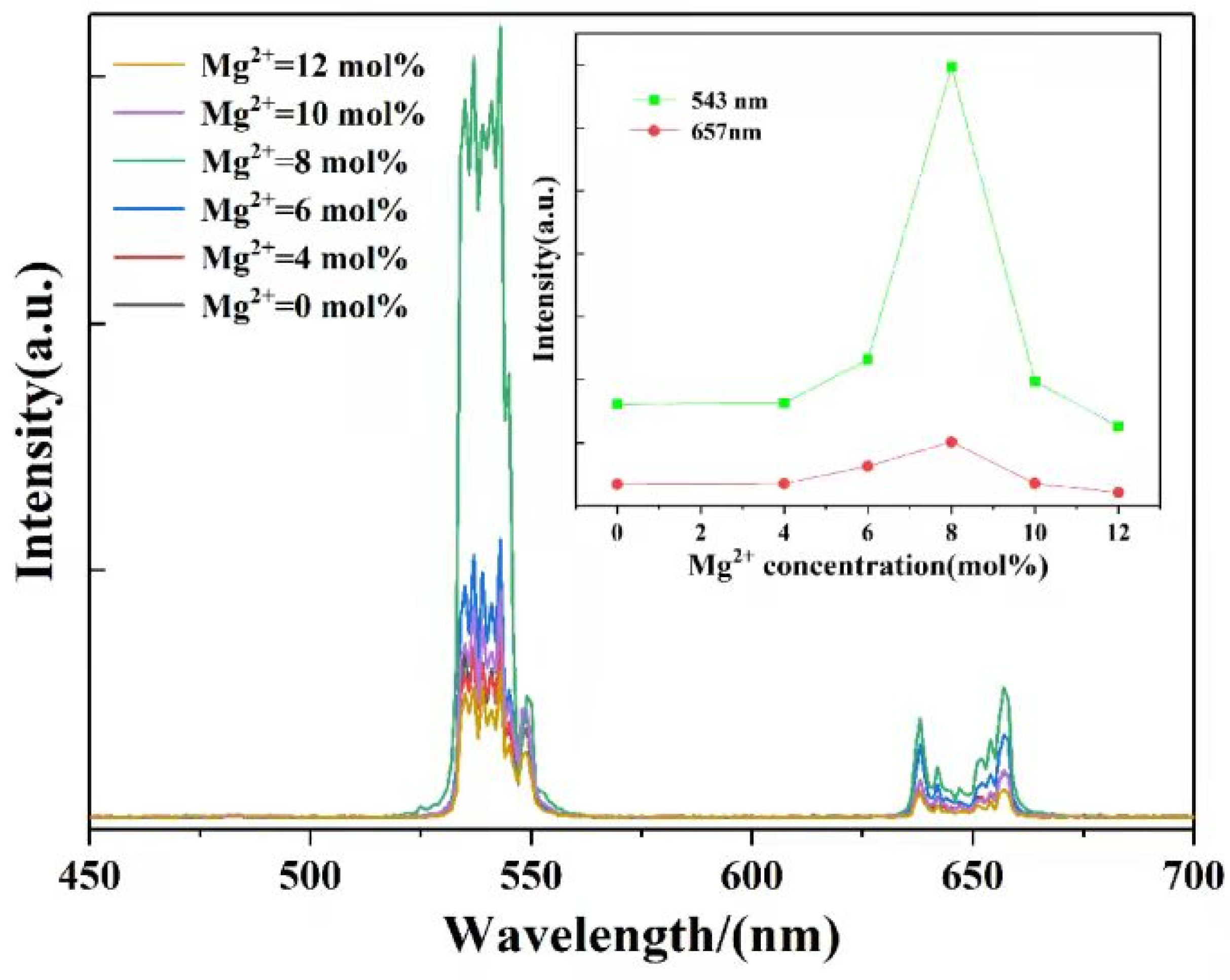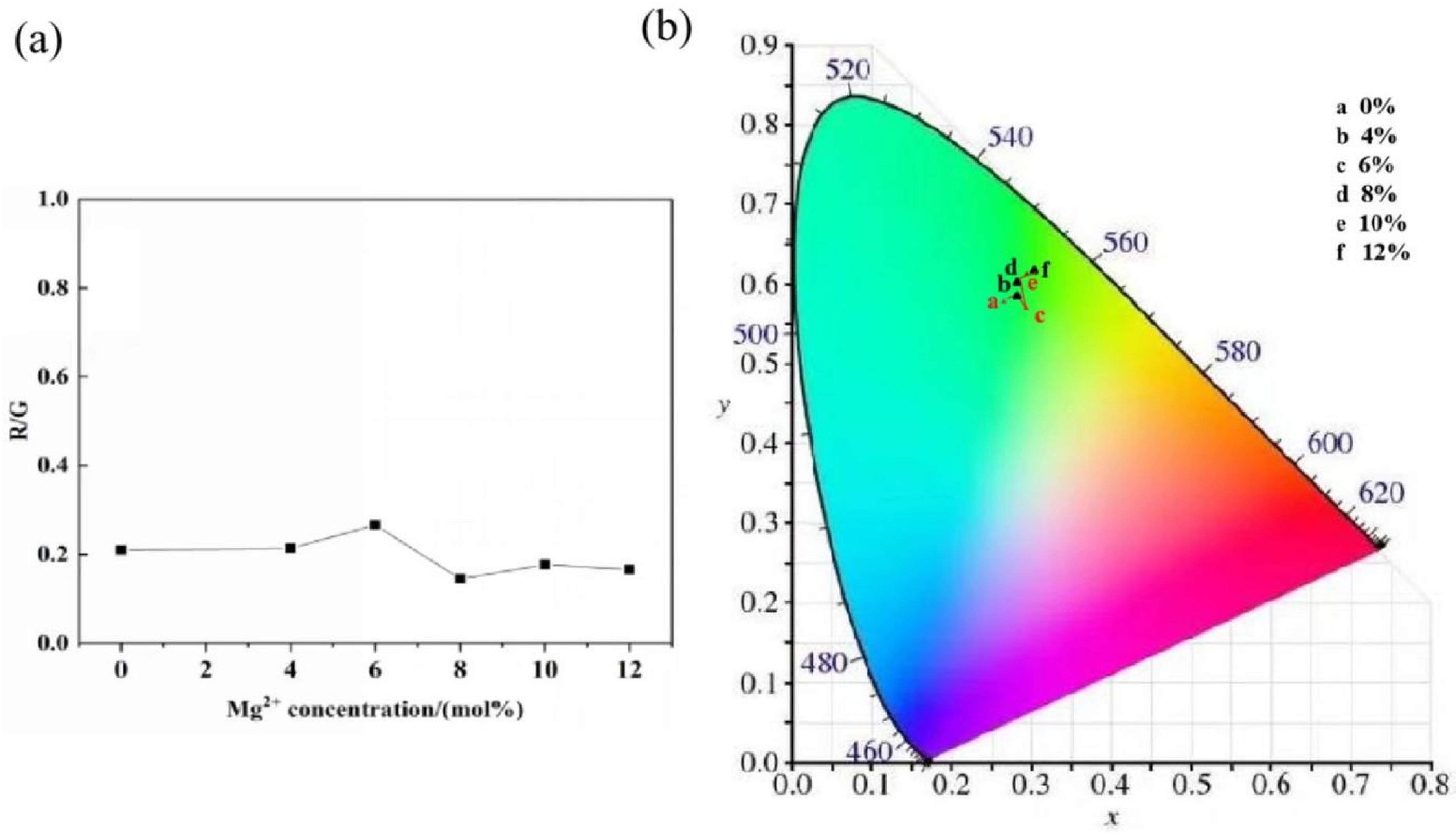Enhanced Upconversion Photoluminescence of LiYF4: Yb3+/Ho3+ Crystals by Introducing Mg2+ Ions for Anti-Counterfeiting Recognition
Abstract
:1. Introduction
2. Experimental Section
3. Results and Discussion
4. Conclusions
Supplementary Materials
Author Contributions
Funding
Institutional Review Board Statement
Informed Consent Statement
Data Availability Statement
Conflicts of Interest
References
- Gai, S.; Li, C.; Yang, P.; Lin, J. Recent progress in rare earth micro/nanocrystals: Soft chemical synthesis, luminescent properties, and biomedical applications. Chem. Rev. 2014, 114, 2343–2389. [Google Scholar] [CrossRef] [PubMed]
- Fan, S.; Gao, G.; Lin, Z.; Li, W.; Fan, S.; Sun, S.; Sun, H.; Hu, L. Highly stable and efficient pure green up-conversion emission of rod-like β-NaGdF4:Yb3+,Ho3+ submicro-crystals via ion-exchange for fluorescent labeling. J. Mater. Chem. C 2018, 6, 5210. [Google Scholar] [CrossRef]
- Xu, X.K.; Li, W.; Zhou, W.; Tan, G.P.; Zheng, Y.H.; Hu, C.F.; Lei, B.F.; Zhang, X.J.; Liu, Y.L.; Zhuang, J.L. Preparation and properties of dual-mode luminescent NaYF4:Yb,Tm@SiO2/carbon dot nanocomposites. J. Mater. Chem. C 2018, 6, 10360. [Google Scholar] [CrossRef]
- Homann, C.; Krukewitt, L.; Frenzel, F.; Grauel, B.; Würth, C.; Resch-Genger, U.; Haase, M. NaYF4:Yb, Er/NaYF4 Core/Shell Nanocrystals with High Upconversion Luminescence Quantum Yield. Angew. Chem. Int. Edit. 2018, 57, 8765. [Google Scholar] [CrossRef] [PubMed]
- Pilch, A.; Wawrzyńczyk, D.; Kurnatowska, M.; Czaban, B.; Samoć, M.; Strek, W.; Bednarkiewicz, A. The concentration dependent up-conversion luminescence of Ho3+ and Yb3+ co-doped β-NaYF4. J. Lumin. 2017, 182, 114–122. [Google Scholar] [CrossRef]
- Zhou, B.B.; Xu, B.; He, H.M.; Gu, Z.J.; Tang, B.; Ma, Y.; Zhai, T.Y. Enhanced green upconversion luminescence in tetrahedral LiYF4:Yb/Er nanoparticles by manganese(II)-doping: The key role of the host lattice. Nanoscale 2018, 10, 2834–2840. [Google Scholar] [CrossRef]
- Li, Y.B.; Li, X.L.; Xue, Z.L.; Jiang, M.Y.; Zeng, S.J.; Hao, J.H. M2+ Doping Induced Simultaneous Phase/Size Control and Remarkable Enhanced Upconversion Luminescence of NaLnF4 Probes for Optical-Guided Tiny Tumor Diagnos. Adv. Healthc. Mater. 2017, 6, 1601231. [Google Scholar] [CrossRef]
- Yang, Y.X.; Xu, Z.; Zhao, S.L.; Liang, Z.Q.; Zhu, W.; Zhang, J.J. Shape controllable synthesis and enhanced upconversion photoluminescence of β-NaGdF4:Yb3+, Er3+ nanocrystals by introducing Mg2+. Chin. Phys. B 2017, 26, 7. [Google Scholar] [CrossRef]
- Ding, M.Y.; Ni, Y.R.; Song, Y.; Liu, X.X.; Cui, T.L.; Chen, D.Q.; Ji, Z.G.; Xu, F.; Lu, C.H.; Xu, Z.Z. Li+ ions doping core–shell nanostructures: An approach to significantly enhance upconversion luminescence of lanthanide-doped nanocrystals. J. Alloys Compd. 2015, 623, 42–48. [Google Scholar] [CrossRef]
- Ding, M.Y.; Cui, S.S.; Fang, L.; Lin, Z.X.; Lu, C.H.; Yang, X.F. NIR-I-Responsive Single-Band upconversion Emission through Energy Migration in Core–Shell–Shell Nanostructures. Angew. Chem. Int. Ed. 2022, 61, 03631. [Google Scholar] [CrossRef] [PubMed]
- Yao, W.J.; Tian, Q.Y.; Liu, J.; Wu, Z.H.; Cui, S.Y.; Ding, J.; Dai, Z.; Wu, W. Large-scale synthesis and screen printing of upconversion hexagonal-phase NaYF4:Yb3+,Tm3+/Er3+/Eu3+ plates for security applications. J. Mater. Chem. C 2016, 26, 6327. [Google Scholar] [CrossRef]
- Kumar, P.; Singh, S.; Gupta, B.K. Future prospects of luminescent nanomaterials based security ink: From synthesis to anti-counterfeiting applications. Nanoscale 2016, 8, 1429. [Google Scholar] [CrossRef] [PubMed]
- Yao, W.J.; Tian, Q.Y.; Liu, J.; Xue, Q.W.; Li, M.X.; Liu, L.; Lu, Q.; Wu, W. Preparation and RGB Upconversion Optic Properties of Transparent Anti-Counterfeiting Films. Nanoscale 2017, 9, 15982. [Google Scholar] [CrossRef] [PubMed]
- Li, D.D.; Mo, J.Y.; Wang, C.; Wu, Z.W.; Hao, A.H.; She, J.B. Enhanced upconversion emission of NaGdF4: Yb3+/Tm3+ crystals by introducing Li+ ions for anti-counterfeiting recognition. Appl. Phys. A 2021, 127, 522. [Google Scholar] [CrossRef]
- Andres, J.; Hersch, R.D.; Moser, J.E.; Chauvin, A.S. A New Anti-Counterfeiting Feature Relying on Invisible Luminescent Full Color Images Printed with Lanthanide-Based Inks. Adv. Funct. Mater. 2014, 24, 5029. [Google Scholar] [CrossRef]
- Yi, J.; Qu, J.B.; Wang, Y.A.; Zhou, D.C. Preparation and characterization of nanosized GdxBi0.95−xVO4: 0.05Eu3+ solid solution as red phosphor. Chin. Phys. B 2014, 23, 104224. [Google Scholar] [CrossRef]
- Yang, J.Z.; Qiu, J.B.; Yang, Z.W.; Song, Z.G.; Yang, Y.; Zhou, D.C. Preparation and upconversion luminescence properties of Ba5SiO4Cl6: Yb3+, Er3+, Li+ phosphors. Acta Phys. Sin. 2015, 64, 138101. [Google Scholar] [CrossRef]
- Li, W.C.; Xu, J.X.; He, Q.; Sun, Y.; Sun, S.Y.; Chen, W.; Guzik, M.; Boulon, G.; Hu, L.L. Highly stable green and red up-conversion of LiYF4:Yb3+, Ho3+ for potential application in fluorescent labeling. J. Alloys Compd. 2020, 845, 155820. [Google Scholar] [CrossRef]







Publisher’s Note: MDPI stays neutral with regard to jurisdictional claims in published maps and institutional affiliations. |
© 2022 by the authors. Licensee MDPI, Basel, Switzerland. This article is an open access article distributed under the terms and conditions of the Creative Commons Attribution (CC BY) license (https://creativecommons.org/licenses/by/4.0/).
Share and Cite
Li, D.; Wang, J.; Wang, C.; She, J. Enhanced Upconversion Photoluminescence of LiYF4: Yb3+/Ho3+ Crystals by Introducing Mg2+ Ions for Anti-Counterfeiting Recognition. Photonics 2022, 9, 614. https://doi.org/10.3390/photonics9090614
Li D, Wang J, Wang C, She J. Enhanced Upconversion Photoluminescence of LiYF4: Yb3+/Ho3+ Crystals by Introducing Mg2+ Ions for Anti-Counterfeiting Recognition. Photonics. 2022; 9(9):614. https://doi.org/10.3390/photonics9090614
Chicago/Turabian StyleLi, Dongdong, Jinghua Wang, Chong Wang, and Jiangbo She. 2022. "Enhanced Upconversion Photoluminescence of LiYF4: Yb3+/Ho3+ Crystals by Introducing Mg2+ Ions for Anti-Counterfeiting Recognition" Photonics 9, no. 9: 614. https://doi.org/10.3390/photonics9090614
APA StyleLi, D., Wang, J., Wang, C., & She, J. (2022). Enhanced Upconversion Photoluminescence of LiYF4: Yb3+/Ho3+ Crystals by Introducing Mg2+ Ions for Anti-Counterfeiting Recognition. Photonics, 9(9), 614. https://doi.org/10.3390/photonics9090614



